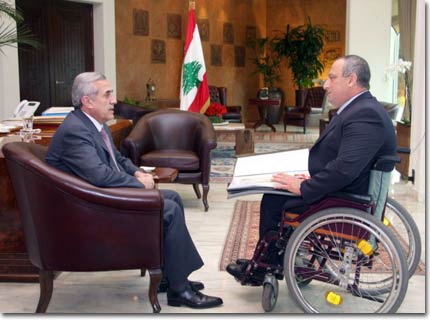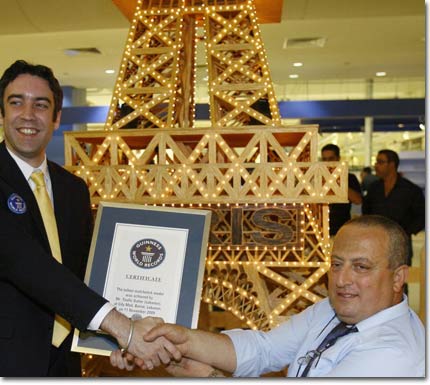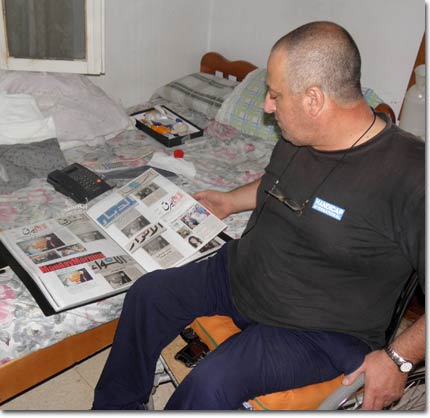Toufic Daher Passed away on December 25th, 2021
Famed for his Matchstick Models
Toufic Daher dreams of founding a permanent museum in Lebanon, the first of its kind.
Life has not been kind to him, but a little matchstick was all that was needed to give light to his life, which was plunged into darkness. In 1988 Toufiq Daher was seriously hurt in an accident which resulted in him being paralyzed, but that is not the end of the story, five years later, in 1993, he had trouble with the law and was in prison, where he spent five whole years. It was there that he discovered the rather unusual art of making models out of matchsticks, one that he brought to perfection.
“It was in prison that I discovered it!” This was how his first creation came to be: “My first realization,” Daher remembers, “was a lighter holder of sixty-four matchsticks. Subsequently, my work went from strength to strength, with envelopes for packets of tissues and cigarettes. My next idea was to make a boat ninety centimeters long, and this took me four whole months of steady work. In August of 1997, I was freed from the prison thanks to a special amnesty granted by the President of the Republic, Elias Hrawi.”
Daher continued: “In the prison, we were allowed to listen to the radio and so I heard about two exhibitions organized in Lebanon. I dreamed of taking part, especially as I sent my work to my mother for her to keep at home. After being freed, I achieved my ambition and took part in several exhibitions. In 1997, I showed my work in the Salle de Verre of the Ministry of Tourism, and since then I have never let an exhibition pass by without showing my production, for example, Expo Beirut, the International Rashid Karameh Exhibition, Futuroscope, and so on, but for the last two years this movement has been suspended, following the assassination of Prime Minister Rafiq Hariri.”
Was this an event that moved him much? Daher insisted, “When I left prison I had lost everything and was completely broke, without a cent. On December 30th, still in 1997, the minister Michel Eddeh saw my work and bought a backgammon board and a small boat, for which he paid me well, and this affected me greatly as these were the first items I had sold. He is a kind-hearted man whom I respect. At the same time, I received a prize for my whole collection.”
In 1998 Daher set about constructing a model of the citadel of Baalbek, something which took him three and a half months, and after that appearances in the press came in succession. “The first review that spoke about me was Al-Amn, while the first dailies were Ad-Diyar followed by Al-Bayrak. But in answer to a question about my future hopes during an interview on the television canal LBC, I confided that I dreamed of doing the famous ship Titanic. This reply brought a laugh from the lady presenter. It was then that I decided to take up the challenge.”
As for the technique he uses, Daher stresses that he takes photographs of his model or of anything he might wish to reproduce. He then looks into the details and starts getting on with the job. To make the matches flexible, he soaks them in water; to get rid of the red color, he lights the head and removes it. If he needs black color, he lights the heads without taking them off.
The next work he executed was the statue of Our Lady of Harissa with the tower on which she stands. This needed eight months of work and 130,000 matches, of which 16,000 were for the statue itself. Small lamps were added. Next, he made a model of the steamship Titanic, having seen the story of her shipwreck in the famous film. This model, three meters long, 60 centimeters wide and 180 centimeters high, is formed of six stories, without the use of a single nail, glue being the only material employed. As he had done for his other models, he lit it up with little lamps, in this case 2,100 of them.
On August 25th, 2002, the reputation of Daher passed beyond our frontiers and his name entered history with an entry in the Guinness Book of Records for “the biggest model of a ship made of matchsticks”. The next model was one of the Eiffel Tower, and this took him four years, from early in 2002 to 2004.
”I commenced with the base, which was four meters square, for a height of about seven meters. Its illumination needed 6,240 lamps and twenty-two flashers, the whole lot being provided thanks to Paul Ayanian. As for the total cost of the work, eleven thousand dollars, this was covered by Mme. Margot Kebbeh, an outstanding society personality, highly cultivated, elegant, and of a rare kind heart, who helped and encouraged me by paying the whole sum. Now an idol of mine, she always supports me and has helped me to set up a workshop at my home in Fraikeh, the home village of Mikhael Neaimeh and Ameen Rihani.”
In the year 2004, Daher was congratulated by the President of the Republic, General Emile Lahoud. “This was a pleasant surprise,” he said. “It was the Head of State himself who sent a delegation to my home in Fraikeh to present me with a Lebanese flag that he had signed and that I stuck on top of the tower. This honor was followed by a congratulatory message from M. Philippe de Courtier, the then-French ambassador. In 2005 I also received a shield of appreciation from President Lahoud, not forgetting the Prize of Lebanon for Artistic Craftsmanship bestowed on me in 2002 by the Association Makhzoumi.”
The artist Toufic Daher was honored in January 2011 by the Minister of Social Affairs Mr. Salim Al Sayegh and they put the first match stick for his project of the Al Aqsa Mosque.

Matches are tender but they hide as well passion and the strength of fire!
William MATAR
Article in French:
Réputé pour ses maquettes en allumettes – Revue du Liban 2007
Toufic Daher rêve de fonder un musée permanent, premier de son genre au Liban
La vie ne lui a pas souri, mais il a suffi d’une petite allumette pour illuminer ses jours qui basculaient dans le noir. En 1988, Toufic Daher a été blessé suite à un incident, ce qui a provoqué sa paralysie, mais ce n’est pas la fin de l’histoire, car après cinq ans, en 1993, il a eu des problèmes avec la justice et il est entré en prison ou il est resté cinq années entières, C’est là où il a découvert l’art assez curieux et original de confectionner des maquettes avec des allumettes, qu’il a développé et perfectionné.
"C'est inné, dit-il, un talent qui a grandi en moi le plus naturellement du monde. C'est dans la prison que je l'ai découvert". Sa première création il la réalisé ainsi: "J'avais besoin de matériel pour exécuter mes œuvres et comme en prison, c'était presque impossible, j'ai eu recours à ma mère et mes visiteurs pour m'apporter le matériel nécessaire. Ma première réalisation, se souvient Daher, est un porte-briquet (64 allumettes). Ensuite, les travaux se sont succédé: cadre d'une photo, enveloppes de boites de mouchoirs et de paquets de cigarettes, tableaux de trictrac… Ensuite, une idée m'est venue, confectionner un bateau de 90cm, qui a exige de moi quatre mois de travail". En aout 1997, il a été libéré de la prison grâce à une amnistie spéciale du président de la République Elias Hraoui.
A-t-il participé à des expositions?
Il déclare: "En prison, il nous était permis d'écouter le radio et je prenais connaissance des expositions organisées au Liban. Je rêvais d'y participer, surtout que j'envoyais tous mes travaux à ma mère pour les garder à la maison. Apres ma libération, j'ai réalisé mon rêve et j'ai participé à plusieurs expositions dont une en l'église Mar-Fawka dans la région de Jounieh. La plus grande, a-t-il ajouté, était celle organisée le 16 décembre 1997, dans l'ancien souk de Zouk. Dans la même période, j'ai exposé mes œuvres dans la salle de verre du ministère du tourisme et depuis, je ne laisse aucune exposition sans y présenter mes travaux tels Expo Beyrouth, exposition internationale de Rachid Karamé, Futuroscope et autres, mais cela fait deux ans que ce mouvement s'est arrêté depuis l'assassinat du président Rafic Hariri". Un événement qui l'a ému? Il souligne: “Quand je suis sorti de prison, j'ai tout perdu et j'étais fauché sans un sou. Le 30 décembre et toujours en 1997, le ministre Michel Eddé a vu mes œuvres et a acheté un tableau de trictrac et un petit bateau qu'il a bien payés, ce qui m'a ému puisque c'étaient les premières œuvres que je vendais. C'est un homme de grand cœur que je respecte. Dans le même temps, j'ai reçu un prix pour l'ensemble de mes travaux". En 1998, Daher a commencé par la réalisation de la citadelle de Baalbek, une œuvre ayant exigé de lui trois mois et demi de travail et des lors, ses apparitions dans la presse se sont multipliées. "La première revue qui a parlé de moi est Al-Amn, quant au premier quotidien, ce fut Ad-Diyar suivi par Al-Bayrak. Mais dans une interview accordée a la chaine de television LBC et en réponse a une question sur mes aspirations futures, j'ai confié que je rêvais de réaliser le fameux bateau Titanic. Une réponse qui a suscité le rire de la présentatrice. C'est alors que j'ai décidé de relever ce défi". Sur la technique qu'il adopte, Daher souligne qu'il prend des photos du modèle ou de tout ce qu'il veut confectionner. Ensuite, il regarde les détails et commence par l'exécution. Pour rendre les allumettes malléables, il les met dans l'eau et pour se débarrasser de la couleur rouge, il en allume les bouts et les enlève. S'il a besoin de la couleur noire, il les allume sans les enlever.
L'œuvre qu'il a réalisée, ensuite, a été la statue de Notre-Dame de Harissa avec la tour qui ont nécessité l'utilisation de cent trente mille allumettes (dont seize mille pour la statue) et huit mois de travail et qu'il a illuminée avec de petites lampes. Ensuite, il a réalisé le Titanic, qu'il a vu dans le célèbre film relatant l'histoire de son naufrage. Cette œuvre longue de trois mètres, large de 60cm et haute de 180cm, est formée de six étages avec tous les détails sans un seul clou puisque la colle est le seul matériel utilise. Et à l'instar de toutes ses œuvres, il l'a illuminée avec 2.100 lampes.
Le 25 août 2002, la réputation de Daher a dépassé nos frontières puisque son nom est entré dans l'Histoire s'étant vu attribuer le record Guinness pour "le plus grand navire construit en allumettes". La maquette suivante a été la tour Eiffel. "Je ne l'ai jamais vue en direct, a-t-il souligné, et la seule idée que j'en ai est ce que j'ai vu à la télévision. Une œuvre qui a exigé de moi quatre ans de travail (2000-2004). J'ai commence par la base qui est de 4m2, quant à la hauteur de la tour, elle a atteint environ sept mètres. Son illumination a nécessité six mille deux-cent quarante lampes et 22 "flasher", le tout offert par Paul Ayanian. Quant au coût total de la réalisation qui est de onze mille dollars, il a été couvert par Mme Margot Kebbe, figure éminente de la société et personne cultivée, élégante et d'une rare humanité qui m'a aidé et encouragé en payant toute la somme. Devenue pour moi une idole, elle me soutient toujours et m'a aide à construire un atelier dans ma résidence a Fraiké, village d'origine de Mikhael Neaime et de Amine Rihani".
Sur une question concernant les prix ou les hommages qui lui ont été rendus, Daher a souligné qu'après le succès réalisé par la tour Eiffel, il a reçu en 2004 les félicitations du président de la République, le général Emile Lahoud. "Ce qui m'a agréablement surpris, a-t-il dit, c'est que le chef de l'Etat a envoyé une délégation officielle à mon domicile à Fraiké pour me remettre un drapeau libanais qu'il a signé et que j'ai fixé au haut de la tour. Un honneur qui a été suivi par un message de félicitation de M. Philippe de Courtier, ambassadeur de France a l'époque. En 2005 également, j'ai reçu un écusson d'appréciation du président Lahoud, sans oublier le prix du Liban pour la création artisanale que l'Association Makhzoumi m'a décerné en 2002".
Sa dernière réalisation est le bateau koweitien Al-Boum, symbole de l'Etat du Koweit qu'il a exposé le 25 février à l'occasion de la fête nationale koweitienne. Daher a terminé un bateau phénicien, travaille sur une église, aspire à réaliser la mosquée de Al-Aqssa et l'église de Jérusalem dans une seule maquette. Son rêve ? Fonder un petit musée permanent pour exposer ses travaux, le premier de son genre au Liban, bien que beaucoup de personnes visitent son atelier à Fraiké et admirent ses œuvres depuis 2001.
L'artiste Toufic Daher a été honoré en Janvier 2011 par le ministre des affaires social Mr. Salim El Sayegh et on a mis le premier bâton d'allumette pour son projet de la Mosquée Al Aqsa.

President Suleiman and the artist

Guinness

Toufic Daher with the Press Articles - October 2010